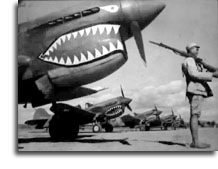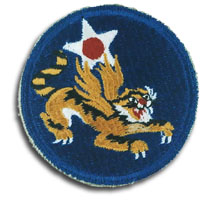| Prelude
to War Flying Tigers The U.S.S. Reuben James |
![]()
 |
|
| "A Chinese soldier guards a line of American P-40 fighter planes, painted with the shark-face emblem of the `Flying Tigers,' at a flying field somewhere in China.". (NWDNS-208-AA-12X-21) | |
Shortly after the Japanese attacked China in July 1937, and before the United States officially entered the war with Japan, Americans were fighting the Japanese in China. They were on hand as observers, advisers, and even recruiters for foreign air forces. They had to be extremely cautious in their activities since the United States was neutral at that time. One of these Americans was retired Army Capt. Claire L. Chennault.
During the summer of 1941, Chennault helped form and train a small group of former Army, Air Force, Navy, and Marine Corps pilots. The American Volunteer Group (AVG) was popularly known as the Flying Tigers because of their aircrafts' distinctive shark's mouth paint scheme. The Flying Tigers did not see combat until December 18, 1941. On July 4, 1942, the AVG was disbanded, and many of the pilots left to return to their original military services. Those few who remained formed the cadre of the 23rd Fighter Group. This unit was part of the 14th Air Force, whose insignia shows its lineage.
 |
Squadron Comdr. Gregory Boyington was a highly successful Tiger, a future Medal of Honor winner and Marine Corps fighter ace who shot down six Japanese planes during this period. On July 4, 1942, the AVG transferred to the Army Air Force and eventually became the 14th Air Force, whose insignia shows its lineage. |